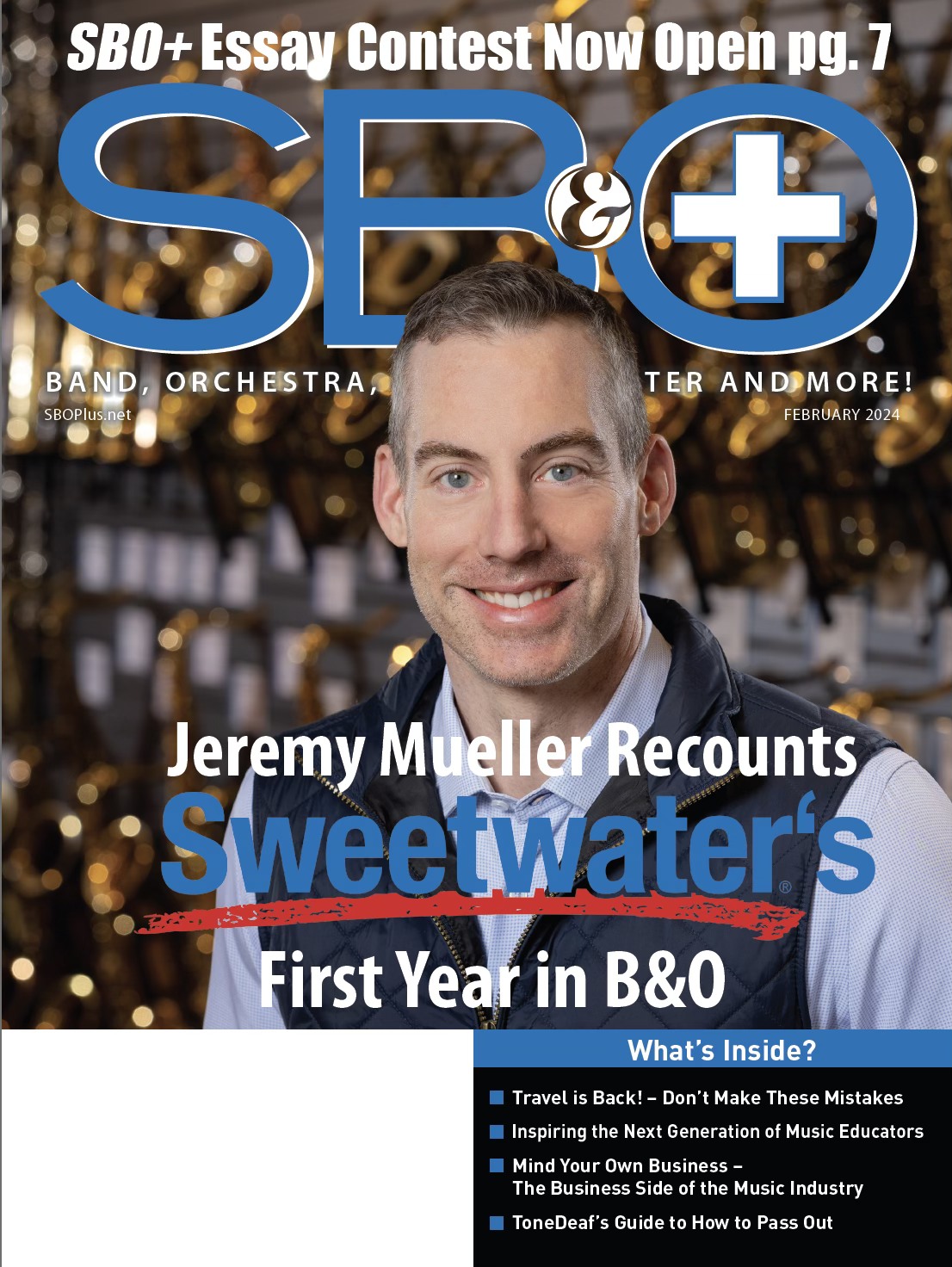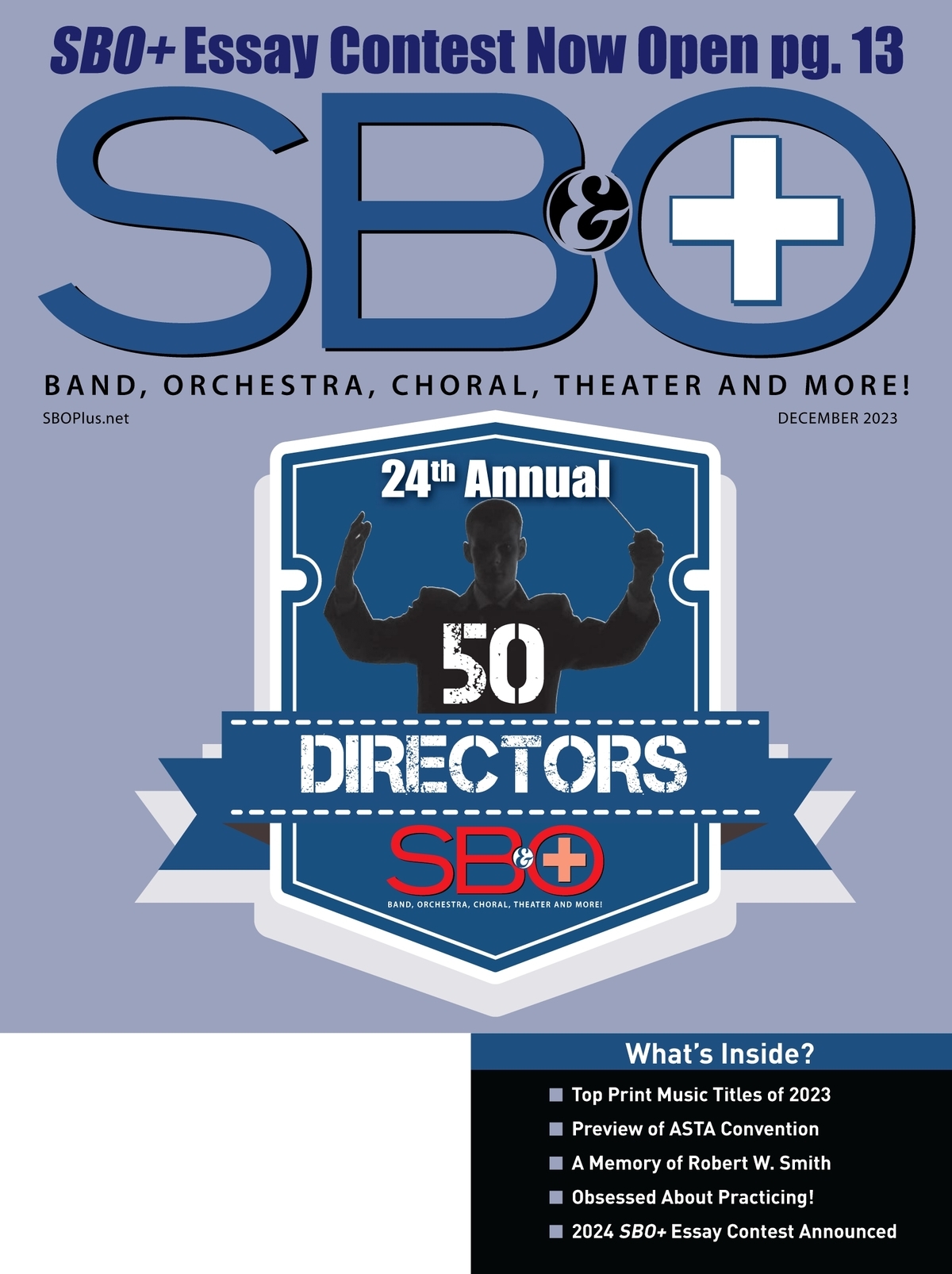EDUCATORS SUBSCRIBE FOR AS LOW AS $0.00! CLICK HERE!
-

Rock of the Nation
Mike Lawson | July 24, 2007With over thirty locations around the country and plans for hundreds more, the School of Rock Music is expanding rapidly. Band directors might be well served by turning their students on to Paul Green's program and the "non-traditional" extracurricular musical opportunities it provides.
School Band & Orchestra: Are you a musician yourself?
Paul Green: Yes, I play the guitar. I picked it up when I was about 12 or 13.SBO: What brought that on?
Read More...
PG: My mom played. She showed me a few chords and how to play them. It came to me pretty easily, so I stuck with it. I took a few lessons off and on, but I'm mostly self-taught. -

Automatic Accompaniment Generating Software: More Home Practicing Recommendations Part Four of Four
Mike Lawson | May 23, 2007Music Minus One (1950) and Jamey Aebersold (1966) were the first to bring the magic of group performance into the practice room with analog play-along recordings and materials. Now, powerful automatic generating software applications have made play-alongs more exciting and accessible. SmartMusic by MakeMusic, with its interactive accompaniments and assessment capabilities, Band-in-a-Box by PG Music, with their extensive play-along accompaniments for more creative teaching and home practice, and StarPlay by In The Chair, with interactive on-line video, are today's must-see automatic accompaniment generators.
Band-in-a-Box
Band-in-a-Box by PG Music (www.pgmusic.com) has been the nearest thing to "artificial intelligence" in music technology since 1987. It provides incredible opportunities to make customized play-along recordings for students to practice with in school, at home, or on the Internet. Its well-thought out menus and powerful sequencing features offer valuable shortcuts and great teaching opportunities.Band-in-a-Box is especially good for designing contemporary music play-along accompaniments for jazz band charts. Simply input the chords and select a musical style and - voila! - the software instantly creates an authentic sounding rhythm section accompaniment in any key and tempo for extended play-along practice. This can then be saved as an audio file for playback on the school or band Web site, duplicated on CDs or MP3 files to be distributed to students, or posted on the Internet for students to practice with. Since the music is being Band-in-a-Box generated by the computer, there are no copyright violations for duplicating or distributing the files created.
Read More... -

Jose Antonio Diaz: Building a Jazz Foundation
Mike Lawson | October 22, 2006By Jennifer H. McInerney
Bringing the music - and the artists - to his students has been an important layer in the jazz foundation Jose Antonio Diaz has been working to build since he came to MacArthur High School , in Houston , Texas , 19 years ago.
In the early 1990s, Diaz and his band program offered a local jazz festival designed to bring high school ensembles together for competition and clinics by renowned guest artists. When he realized that only his students were sticking around for the clinics, Diaz adjusted the focus away from competition, in favor of his education-driven goals: he eliminated the competitive festival and brought the guest artists directly to his students for in-school clinics. The students in the MacArthur bands have responded so well to the guest artists program that Diaz has worked to continually expand the network of clinicians and develop a lasting rapport with each of them.
Read More... -

Notation Software on a Budget
Mike Lawson | October 22, 2006Music composition/arranging is perhaps one area of music standards in K-12 education that is even more neglected than improvisation. Instructors may rationalize that the cost of a music notation application is too expensive. Also, composing/arranging without music notation software can be a rather tedious handwritten activity.
With computers, you can print, edit and transpose in seconds as well as instantly hear your composition for feedback purposes. But implementing this technology can be a tricky matter because most students can’t afford to have such programs at home, and school may have time limitations. However, there is good news to report. Music notation products under $100 are now numerous, versatile and rather powerful. There are also some good freeware options.
Read More... -

Daniel Levin
Mike Lawson | October 21, 2006Many teachers talk about dedication to their students, to their career – and many genuinely mean it – but right off the bat it’s was clear that Amistad Academy’s Daniel Levin truly walks the walk.
Arranging a conversation with Levin was, initially, somewhat of an exercise in frustration. After a couple of false starts, Daniel and I were able to sit down and he apologized for the difficulty in scheduling: “I’m sorry I’ve been so hard to get a hold of,” he said. “It’s been really busy for me the past couple weeks. I would’ve been able to get the days off, because – well it’s my honeymoon right now- but I know all the things I need to do everyday to keep things running. I don’t want to encounter the loss of morale or momentum. It wouldn’t have been acceptable to me, personally, to leave for a long time.”
Such commitment and passion have surely found a fitting home at New Haven’s Amistad Academy, flagship school for Achievement First – a three-school (soon to be four – August 2006) enterprise which aims to help urban students achieve academic and personal excellence. Since coming on board in 2002, Levin has fully immersed himself in the lives and academic futures of his young scholars. An accomplished performer in his own right, Daniel draws upon his own musical abilities and his knowledge of contemporary music technology to truly connect with his students in ways that could serve as a template to any educator.
Read More... -

FromTheTrenches : Changing the World One Life at a Time
Mike Lawson | October 21, 2006 By: Bob Morrison Much has been written about the arguments advocates use to make the case for music and arts programs in our schools. Are such programs vital because of the intrinsic value (music for music's sake), or because of the extrinsic values, such as better grades and higher test scores? Personally, I […] Read More... -

UpFront Achieving variety within an arrangement
Mike Lawson | October 19, 2006We may achieve variety in many ways within a musical arrangement. This example is taken from an arrangement that I did for the opening of the Thanksgiving Parade in Philadelphia for WPVI (ABC-Disney); O Come All Ye Faithful.
It is scored for eleven instruments; three trumpets, two trombones, three saxophones, and three rhythm (piano, bass, and drums). I considered beginning the arrangement with a brass quartet ala chorale-style, but felt that three musical lines moving at different speeds would accumulate the needed tension and momentum, that the parade opening required. These three lines, (in a musical conversation), lead to a forte ensemble passage beginning in m.11 that builds in intensity.
Read More... -

Digital Recording
Mike Lawson | October 1, 2004Digital audio recording can have immediate impact on your music program. Most directors view recording as a final-stage tool exclusively for their concerts, but digital audio recording has opened up a whole new world of audio assessment possibilities. Now music educators can share ongoing improvement with students, parents and administrators via CD, either for distribution, playback and/or Internet posting. Fortunately, this technology has become very accessible and is relatively inexpensive compared to the thousands of dollars such software and hardware cost just a decade ago. Today, we have far more user-friendly and portable recording options that busy educators can take on field trips, use in the classroom, or any take to kind of concert hall.
There are three different types of portable entry-level digital audio recording systems that deserve your investigation - each has certain advantages depending on your needs. The most affordable are small, handheld portable digital recorders that work remotely with batteries and can be used with either the built-in microphone(s) or external microphones. The next level is the mini-size consoles - larger than hand-helds but significantly smaller than rack-mounted units - which usually require A/C for operation. The third tier is software applications for notebook computers, which are relatively inexpensive. However, the notebook hardware requirements of CPU's can be expensive. However, notebook solutions can be a viable alternative solution to larger dedicated hardware units for those of you who already have a high-powered notebook or are looking for good way to use your notebook to record live concerts/rehearsals.
Regardless of which type of digital recording you select, I recommend sticking with one before expanding to others. Be aware that there are two kinds of recordings you can embark on: two-track stereo and multitrack. The advantage of the two-track is that you can easily record the finished product for stereo playback. Multitrack offers more options for editing and mixing the recording after the performance, but two-track recordings can also be enhanced as well.
Read More... -

Automatic Accompaniment Generators
Mike Lawson | August 1, 2004Digital audio recording can have immediate impact on your music program. Most directors view recording as a final-stage tool exclusively for their concerts, but digital audio recording has opened up a whole new world of audio assessment possibilities. Now music educators can share ongoing improvement with students, parents and administrators via CD, either for distribution, playback and/or Internet posting. Fortunately, this technology has become very accessible and is relatively inexpensive compared to the thousands of dollars such software and hardware cost just a decade ago. Today, we have far more user-friendly and portable recording options that busy educators can take on field trips, use in the classroom, or any take to kind of concert hall.
Read More... -

Jazz Applications
Mike Lawson | March 1, 2002My favorite music technology applications are in jazz. Jazz by its very nature is a creative process with many opportunities for improvisation, arranging and composing. Technology opportunities abound in jazz education – and they meet national MENC and local school district music standards.
One of the concerns about jazz education today is that most music educators have not been trained in jazz education techniques, yet are expected to teach it. Consequently, they are hesitant as they experience some limitations in jazz instruction, especially when their ensembles are adjudicated by trained jazz professionals at festivals. But with jazz technology applications, it is possible to accelerate the learning curve toward mastering jazz education principles. Excellent software, interactive CD-ROM, videos, and books are available to expand the jazz education experience.
Read More... -

REPORT: JAZZ CAMPS
Mike Lawson | March 1, 2002For serious jazz students, the summer can be a time to take their playing to the next level. The various summer jazz camps located across the country offer students unique opportunities to improve their technique, style, soloing and improvisational skills through intensive summer courses and workshops. These camps feature professional musicians and clinicians who help […] Read More...





